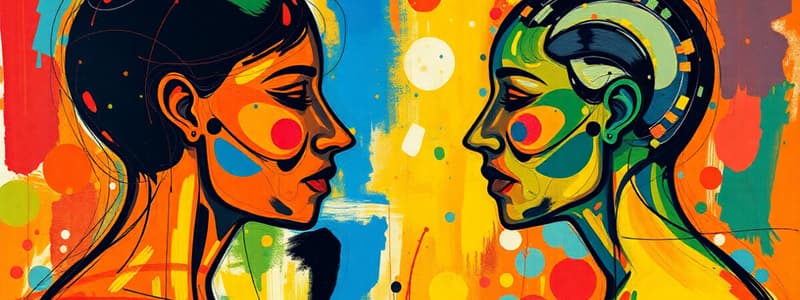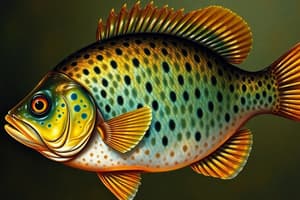Podcast
Questions and Answers
What is intrasexual competition primarily characterized by?
What is intrasexual competition primarily characterized by?
- Mating based solely on territory control
- Competition among members of one sex for mating access (correct)
- Preference for certain physical qualities in mates
- The selection of mates that provide resources
Which of the following statements best describes intersexual selection?
Which of the following statements best describes intersexual selection?
- It results in mating access being evenly distributed among all individuals.
- It has no impact on evolutionary change over time.
- It reflects competition between individuals of the same sex.
- It occurs when individuals of one sex are preferentially chosen by the other based on desirable traits. (correct)
What consequence do successful traits from intrasexual competition tend to have on future generations?
What consequence do successful traits from intrasexual competition tend to have on future generations?
- They become less common over time.
- They result in a loss of genetic diversity.
- They are passed on to the next generation more frequently. (correct)
- They are often disregarded in favor of neutral traits.
Why did Darwin refer to intersexual selection as 'female choice'?
Why did Darwin refer to intersexual selection as 'female choice'?
What might happen to males who lack qualities that are preferentially chosen by females in intersexual selection?
What might happen to males who lack qualities that are preferentially chosen by females in intersexual selection?
What does genetic determinism incorrectly suggest about human behavior?
What does genetic determinism incorrectly suggest about human behavior?
How does evolutionary theory describe human behavior?
How does evolutionary theory describe human behavior?
What does the knowledge of evolved psychological adaptations provide us?
What does the knowledge of evolved psychological adaptations provide us?
What is a key constraint on the optimal design of human adaptations?
What is a key constraint on the optimal design of human adaptations?
Which statement best defines the relationship between evolved adaptations and environmental input?
Which statement best defines the relationship between evolved adaptations and environmental input?
Flashcards are hidden until you start studying
Study Notes
Intrasexual Competition
- Darwin proposed two mechanisms for sexual selection, the first being intrasexual competition.
- Intrasexual competition occurs when individuals of the same sex compete for access to mates.
- A classic example involves stags battling for dominance.
- Winners gain mating access, either directly or through controlling resources desired by females.
- Losers typically fail to reproduce.
- Traits linked to success in intrasexual competition are passed on, while those linked to losing are not.
- This drives evolutionary changes over time.
Intersexual Selection
- The second mechanism is intersexual selection, also known as preferential mate choice.
- In this process, one sex exhibits preferences for specific traits in the opposite sex.
- Individuals with desired traits are preferentially chosen as mates.
- Those lacking these traits often mate less frequently or not at all.
- This leads to an increase in the frequency of desirable traits over generations.
- Darwin termed this process "female choice," observing that females often demonstrate greater selectivity in mate selection than males.
- An example includes females favoring males who offer food gifts, leading to an increase in males adept at acquiring such gifts.
Misunderstanding 1: Human Behavior is Genetically Determined
- Evolutionary theory suggests that human behavior requires both evolved adaptations and environmental input.
- This theory doesn't support genetic determinism, which claims behavior is solely controlled by genes.
- Adaptations evolve to help organisms cope with environmental challenges.
- Genetic determinism is incorrect and not implied by evolutionary theory.
Misunderstanding 2: If It Is Evolutionary, We Cannot Change It
- Understanding our evolved social psychology and the social inputs that activate it can empower us to change behavior.
- Knowledge of mechanisms facilitates change, rather than preventing it.
- While changing behavior might be complex, knowledge of our evolved psychology can help us change in desired areas.
Misunderstanding 3: Current Mechanisms Are Optimally Designed
- The current human adaptations aren't designed perfectly. Two factors contribute to this:
- Evolutionary time lags: We are adapted to past environments, leading to mismatches in today's world.
- Costs of adaptations: Adaptations can have drawbacks, and natural selection favors mechanisms that balance benefits and costs.
- The "Stone Age brain" in a modern environment highlights how our adaptations may not be suited for current conditions.
- Costs of adaptations (e.g., fear of snakes/spiders) can hinder other survival needs, preventing optimal design. Adaptations are reasonably good, but not perfectly designed due to cost constraints.
Studying That Suits You
Use AI to generate personalized quizzes and flashcards to suit your learning preferences.




